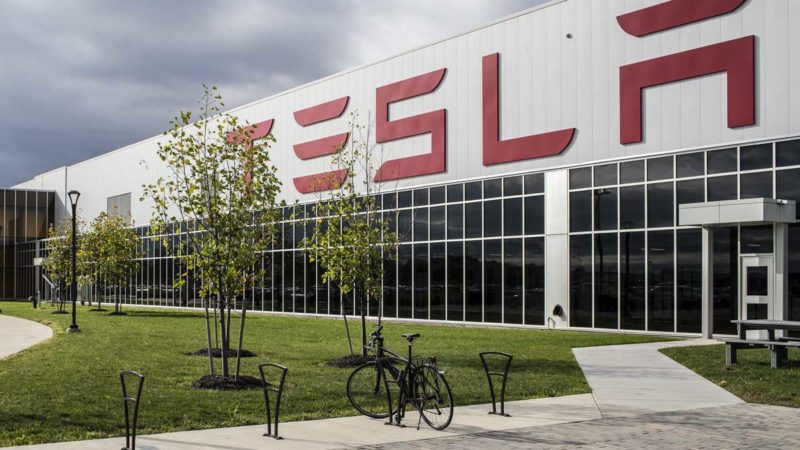Two leading experts on Tesla have given insight into what they expect from Battery Day, which will be held on Tuesday (US time), as a leaked image of a larger, longer battery cell hints at least one major new innovation for the electric car maker.
A possible “Roadrunner” battery image that Electrek reported on Wednesday was shared anonymously to the EV news site, and then reportedly confirmed as coming from Tesla by another independent source.
Roadrunner refers to a battery production facility Tesla has reportedly been working secretly on at its Kato Road facility.
The image shows a wide cylindrical battery, that is estimated to be 29mm longer, and with a much larger diameter that the 2170 cells made in Nevada for Tesla by Panasonic.
If anyone has seen this battery cell before or if you some information about them, please reach out. DM are open or email [email protected] wickr: fredev pic.twitter.com/YxgCYY16fP
— Fred Lambert (@FredericLambert) September 15, 2020
As noted on The Driven on Friday, anticipation for Tesla’s Battery Day is enormous.
It is expected that Tesla boss Elon Musk will unveil a million-mile battery, along with a number of other breakthroughs including a possible wider cell design, that would ideally bring down the cost of making batteries – a critical development given that batteries are the main cause of the high ticket price of EVs.
Musk took to Twitter again on Monday morning (Australian time) to reiterate that Battery Day will be “big”.
It’s big
— Elon Musk (@elonmusk) September 20, 2020
Two experts – one, Tesla bull and founder of Ark Invest Cathie Wood, and the other, a Tesla company and stock watcher known only as “JPR007” – have delved into some of the potential breakthroughs expected to be revealed this week on Twitter.
In our ongoing coverage of what people in the know have to say about Tesla Battery Day, we think it’s worth bringing to your attention.
JPR007 breaks down how he thinks the bigger battery, which also appears to be “tabless” (refer to this article here on why Tesla’s tabless electrode patent is way more important than it sounds according to Musk), could equate to longer range, lower production costs and less need for factory floor space.
Because the cells are longer, and if there is room in existing design of Tesla electric cars made in Fremont, there will be extra capacity embodied in the extra height.
This means either more cells can be added for longer driving range, or a pack with a smaller horizontal footprint could be put to use in a vehicle with a shorter wheelbase (remember those hints that Tesla might make an electric hatchback in China?).
SMALLER CARS
The denser packing is also positive for smaller cars
– because a physically smaller battery pack on the horizontal plane still allows for the same energy content
So the shorter narrower cheaper vehicles start to get some favor
— JPR007 (@jpr007) September 20, 2020
He also notes that the new form factor could also mean Tesla could put to use existing factory lines to make the same number of batteries, but because those batteries have a much higher energy capacity, the overall capacity output is much greater without the need to expand factory floors.
Using estimated dimensions, he calculates output could increase from 68 battery packs a day to 720 packs a day – more than ten times the output.
Even though the calculations are “illustrative” only, you begin to get the idea – simply by making bigger, slightly longer batteries, Tesla is suddently able to feed more demand for batteries, allowing more vehicle production.
TESLA 5590 LINE :
400,000 / 500 cells* = 800 packs per day
90% Yield* —> 720 packs per day
1 line = 720 packs per day @ 80 kWh* each = 58.32 MWh per day x 350 days = 20.41 GWh per year
NOTE : Using * to highlight three changed parameters
— JPR007 (@jpr007) September 20, 2020
He also estimates this means Tesla could output the same energy storage capacity on one line at the Roadrunner facility than Panasonic does with 13 lines – meaning less labour costs, as well as less capital costs.
His closing remark is, “No wonder Tesla has not chosen to expand Gigafactory 1 yet.”
10. NO WONDER TESLA HAS NOT CHOSEN TO EXPAND GF1 YET
– the new paradigm should be confirmed in practice before spending too much money on physical expansions that may be paced out over a longer period
— JPR007 (@jpr007) September 20, 2020
The thread was enough to draw the attention of Cathie Wood, who is well known for her bullish stance towards Tesla on Wall Street, and whose investment company focusses solely on “disruptive innovation.”
If JPR007’s theory plays out, is it possible that Tesla will reduce the cost of batteries in line with “Wright’s Law” which observes that the cost of new technology falls as demand rises?
“Are they more fundamental breakthroughs? Would a 90%+ decline in each of the three important variables – assembly line labor costs, cell cost saving per unit of energy, and factory floor space – change the slope of the line, accelerating the decline in costs from 18%?” she says.
Just two more sleeps (well, in Australia).
According to @skorusARK research, other companies focused on EVs are three to four years behind $TSLA in battery technology already. The question is whether these breakthroughs will help #Tesla pull away even faster.
— Cathie Wood (@CathieDWood) September 20, 2020

Bridie Schmidt is associate editor for The Driven, sister site of Renew Economy. She has been writing about electric vehicles since 2018, and has a keen interest in the role that zero-emissions transport has to play in sustainability. She has participated in podcasts such as Download This Show with Marc Fennell and Shirtloads of Science with Karl Kruszelnicki and is co-organiser of the Northern Rivers Electric Vehicle Forum. Bridie also owns a Tesla Model Y and has it available for hire on evee.com.au.

